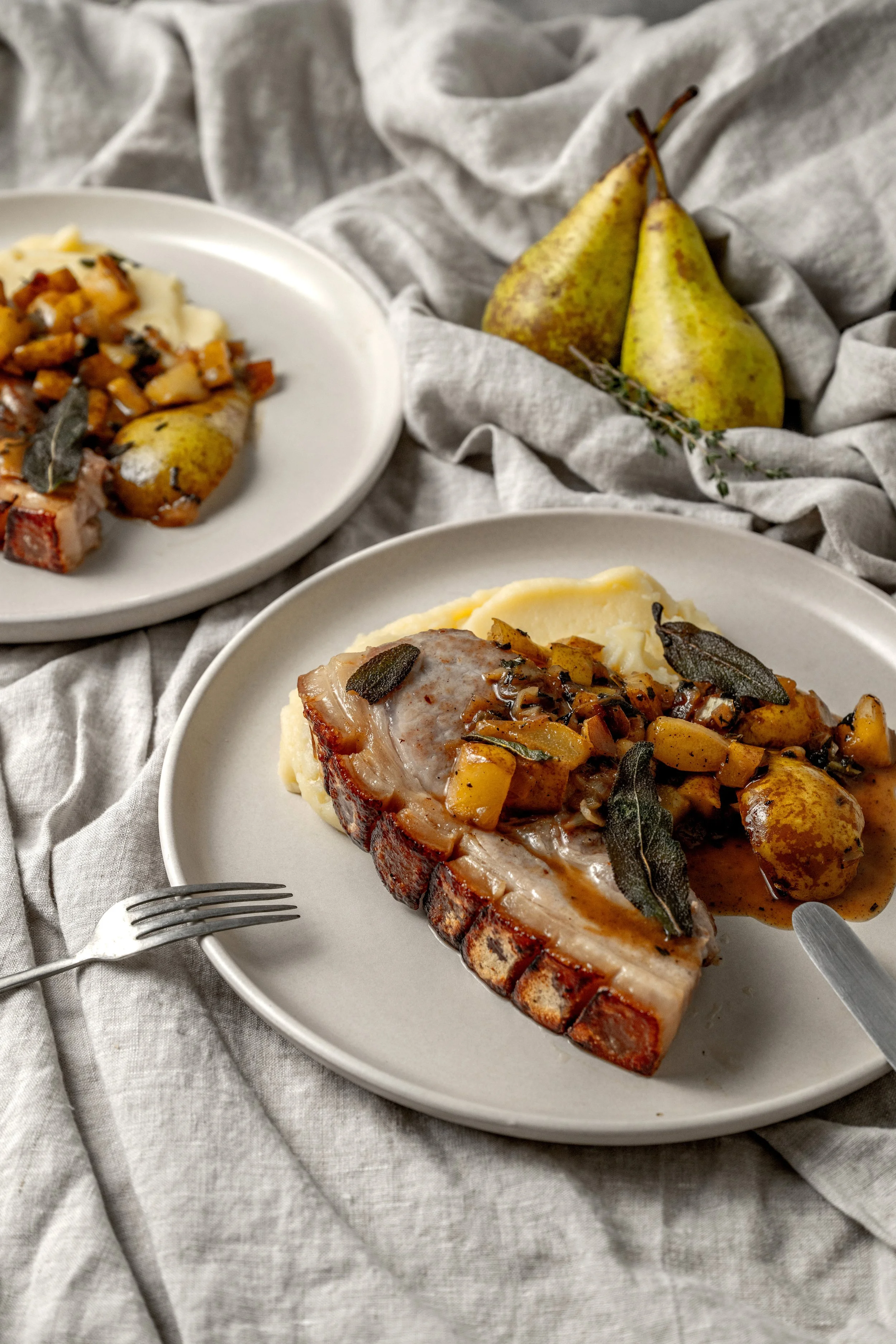Cider Pork Chops with Caramelised Pears and Sage
Thick, butcher-cut pork chops seared until the fat turns golden and crisp, finished in a buttery cider and sage reduction with caramelised pears that stay tender but hold their shape. The sauce is sweet from the pears and cider, balanced by a touch of vinegar and the savoury crunch of fried sage leaves. Brining the chops beforehand is optional but helps them stay juicy and well-seasoned. Serve with creamy mash and greens for a comforting autumn supper.

Cider Pork Chops with Caramelised Pears and Sage
Thick, brined pork chops with crisp fat, caramelised pears and a glossy cider and sage sauce.
Ingredients
- 1l cold water
- 100g fine salt
- 50g caster sugar
- 1 bay leaf
- 3 thyme sprig
- 1 garlic clove, crushed
- 1 strip lemon peel or
- a few black peppercorns
- 2 thick pork chops, boneless fat scored at 1–1.5 cm intervals
- 2 tbsp neutral oil
- Salt and pepper
- 3 tbsp butter
- ½ small onion or 1 shallot, finely diced
- 1 tsp caster sugar
- A few thyme leaves
- 4 sage leaves, finely chopped
- Cider vinegar
- 3 firm pears, halved and cored
- 150ml dry cider (or dry white wine)
- 150ml light chicken or vegetable stock
- Small knob of cold butter (to finish)
- 6–8 sage leaves, fried until crisp in neutral oil
- Flaky sea salt
Instructions
- To make the brine, combine all the ingredients but only 500ml of the water in a large pan. Bring to a gentle simmer until the salt and sugar dissolve and the aromatics infuse. Remove from the heat, add the remaining cold water to cool it down, and leave to rest for about an hour until completely cool.
- Score the fat of each pork chop down to just before the meat, spaced about 1–1.5 cm apart. Submerge the chops in the brine for 2 hours in the fridge. Rinse, pat completely dry completely
- Preheat the oven to 180°C.
- Heat a heavy stainless-steel sauté pan over medium heat with the oil. Hold the chops upright on their fat edge and render slowly for 5–10 minutes until golden and crisp. Lay them flat and sear for 3–4 minutes per side until golden. Transfer to a separate oven tray and roast for about 8 minutes, until the internal temperature reaches 62–63°C. Remove from the oven and rest while you make the sauce.
- While the meat is in the oven, return the sauté pan to medium-low heat the residual pork fat and add the butter. Add the onion and cook gently for 4–5 minutes until translucent, stirring regularly. Stir in the sugar, thyme leaves and chopped sage. Pour in the cider vinegar to deglaze, scraping up all the browned bits and release their flavour into the sauce.
- Chop 2 of the pears into 1 cm dice and add to the pan with the onions for 5 mins then add stock and cider. Cook to reduce with lid on. Chop the remaining pear into quarters and add to the pan. Simmer for 2–3 minutes until glossy and slightly thickened. Swirl in a small knob of cold butter to finish.
- Place a rested pork chop on top of some buttery mash and steamed greens, spoon over some sauce and nestle the pear halves to one side, and scatter with crispy sage leaves and a little flaky salt. Serve immediately.
Nutrition Facts
Calories
545Fat
30 gSugar
11 gProtein
50 gCarbs
0 gApproximate values per serving
Ingredients and sourcing tips
Pork chops
Choose thick-cut chops with a generous fat cap and some marbling through the meat for juiciness. Free-range or rare-breed pork gives the best texture and flavour.
Tips and pitfalls to avoid: Score the fat before brining so the seasoning penetrates evenly and the fat renders cleanly.
Pears
Use firm, slightly under-ripe pears like Conference or Comice so they hold their shape through the caramelisation and reduction.
Timing and texture cues: Add them once the onion is softened, and remove before the sauce tightens.
Cider
A dry, still cider creates a clean reduction without excess sweetness.
Storage and make-ahead: The sauce can be made ahead and rewarmed gently with a splash of stock to loosen.
Variations and dietary swaps
Flavour twists
Add a spoonful of Dijon mustard or a little cream to the finished sauce for richness.
For a winter variation, replace the pears with sliced quince or caramelised apple wedges.
Dietary options
Use vegetable stock for a lighter, dairy-free version, and skip the final butter swirl.
Kitchen notes
Pan choice
A heavy stainless-steel sauté pan is ideal — it builds fond without sticking, handles acid well, and transfers heat evenly. Non-stick won’t brown properly, and cast iron can over-reduce the sauce.
Tips and pitfalls to avoid
Don’t crowd the pan or rush the fat rendering, or the chops will curl and cook unevenly. Keep the sauce at a gentle bubble once deglazed to prevent the sugars catching.
Timing and texture cues
The pears should still look like pears — coloured, slightly tender but not collapsing. The sauce should coat the back of a spoon and stay glossy.
Serving suggestions
How to serve
Serve on warm plates with the sauce beneath for contrast and clean plating. These pair beautifully with celeriac mash, roasted chicory, or simple buttered green beans.
Drinks to pair
Dry cider, crisp Chardonnay, or a light Pinot Noir work perfectly.




